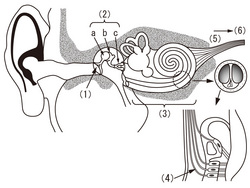Nagoya City Science Museum
TOP > Exhibition Guide > Keyword Search > Starting with "F" > forest > Mysterious Forest of Sound
Mysterious Forest of Sound

Purpose of Exhibition
If you place your forehead on the button of the exhibit, you can hear a sound. Even when you keep your hands closed over your ears, you can still hear it.
Why? It's because of noise transmission by bone conduction.
Please enjoy these unusual and different ways of hearing.
There are three heights of buttons. Three kinds of sounds can be heard. Other than a bird called "Eurasian scops-owl", a kind of small owl, selected as the symbol bird of Aichi Prefecture. You can hear various kinds of insects, too.


Additional Knowledge
[Sound is a Vibration of the Eardrum]
Why do we hear sound? You might think that it's because we have two ears. How do we feel sound vibration? Let's look at it through our ear holes in order. You may think it is a little complicated.
(1) Eardrum (Tympanic membrane): This is a thin membrane in the inner part of the ear. Sound creates air vibrations, which makes the eardrums vibrate. This part of ear is visible from the outside.
(2) Ossicles: A set of little bones connected inside the eardrum.
Vibration is transmitted through the three bones in turn.
(3) Cochlea: this is a snail-form organ. It includes some cells that grow fur.
(4) Auditory cell: This cell have a host of hair-like sensory projections (sensory hair) that receive sound vibrations from the middle ear.
(5) Auditory nerve: This organ transmits sound into the brain from vibrating auditory cell including the type of sound, for example, if it's a loud or small sound, high or low tone, and so on.
(6) Brain: the organ that receives all the information on sound.
[Bone Conduction]
This is a mechanism by which sound is not transmitted through the eardrum (1), but from the bones of the forehead and cheek to the (2) Ossicles.
And then the Ossicles on the head bones vibrate. As a starting point, the information will be transmitted to the brain.
This is the "bone conduction". On the other hand, the transmission of air vibration through the vibration of eardrum is called "air conduction".
When listening to your own voice recorded, it might sound different from when you speak. This is because when listening, both transmission ways are used, but when recording, the "bone conduction" transmission is not used, therefore, the voice sounds different.
[Use of Bone Conduction]
As you can see in the exhibit, even the sound that you do not hear well with your ear can be heard through bone conduction. Moreover, because you don't cover your ears, you can hear different sounds than what you would normally hear through your ears with bone conduction.
Many products have been developed in response to that, including the following:
_ Hearing aids to use in case of injuries and illnesses of the ear.
It does not need to be introduced within the ear canal to hear more clearly.
_ Earphones for TV cameramen.
While listening to surrounding noises, one can clearly hear separate sounds.
If you have a chance to develop a device like this, what kind of products would you think about making?
Article by Tomoko Horiuchi, curator
